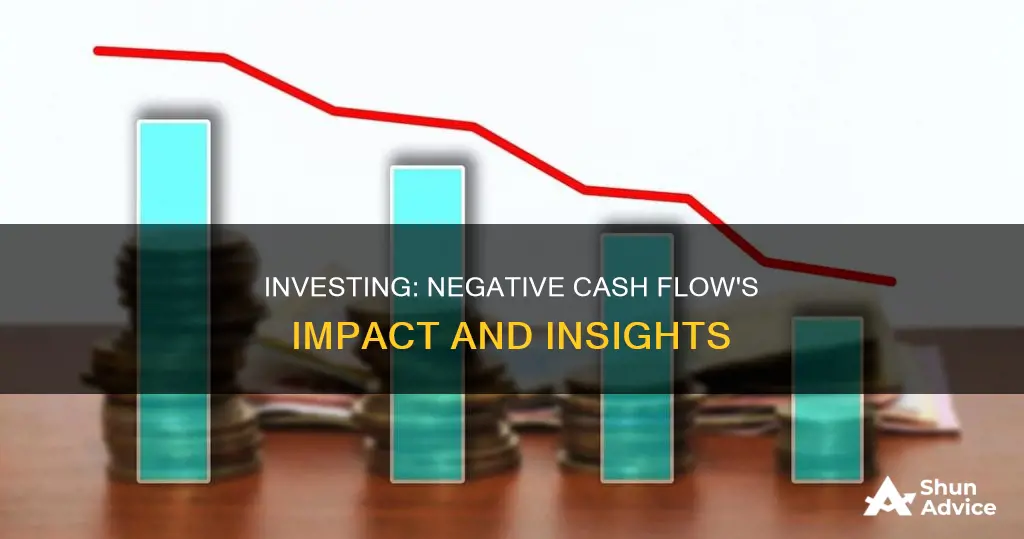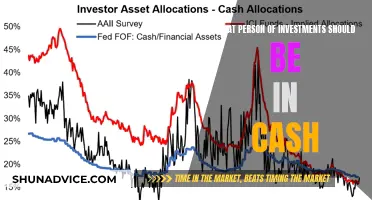
Negative cash flow is a common occurrence for companies in their growth phase, as they need to spend money to fuel growth, acquire customers, or set up distribution channels. It simply means that a company is spending more cash than it is generating. Negative cash flow is not always a bad thing, as it can indicate that a company is investing in its future growth and development. For example, a company may invest in fixed assets such as property, plant, and equipment to grow its business, which will result in negative cash flow in the short term but may generate cash flow in the long term. However, if negative cash flow becomes a common practice over multiple quarters, it can be a sign of a flawed business plan or a lack of growth opportunities.
| Characteristics | Values |
|---|---|
| Definition | When a company's cash spending is more than its cash generation in a particular period. |
| --- | --- |
| Calculation | Cash Flow = Cash Inflows – Cash Outflows |
| --- | --- |
| Cause | Companies in their growth phase often experience negative cash flow as they need to spend money to fuel growth, acquire customers or set up distribution channels. |
| --- | --- |
| Interpretation | Negative cash flow is not always a bad thing. It can be a sign that the company is investing in assets, research or other long-term development activities that are important to the health and continued operations of the company. |
| --- | --- |
| Examples | Netflix, Exxon Mobil |
What You'll Learn

Negative cash flow from investing activities is not always negative
Negative cash flow from investing activities is not always a negative indicator of a company's financial health. While it can sometimes be a warning sign that a company's management is not efficiently using its assets, it can also signal that the company is investing in its future growth.
Negative cash flow from investing activities occurs when a company spends more cash on its investing activities than it receives from them. This means that the company is using its cash to buy or improve its fixed assets, such as buildings, machinery, or technology, or that it is acquiring other businesses or making strategic investments.
For investors, it is important to review the entire cash flow statement and all its components to determine if the negative cash flow is a positive or negative sign. A company's cash flow statement can reveal what phase the business is in. For example, a start-up may be purchasing the facilities or equipment it needs to expand, while a mature business may be developing new lines of business or acquiring rivals.
It is not uncommon for a growing company to have a negative cash flow from investing activities. This may be because the company is investing in long-term fixed assets, which can help its future growth. Even well-established companies make investments in long-term assets from time to time, which can cause a negative cash flow for that period.
For example, a company may have a negative cash flow from investing activities due to the purchase of property, plant, and equipment. While this may have a negative impact on cash flow in the short term, in the long term, these assets could help generate growth in the company's revenue.
In summary, negative cash flow from investing activities can be a sign that a company is investing in its future growth and is not always a negative indicator of financial health.
Understanding Cash Flow: Investing Activities Explained
You may want to see also

It can indicate a company's poor performance
Negative cash flow can indicate a company's poor performance, but this is not always the case. It can also indicate that the company is investing in long-term assets and development activities that are important to its health and continued operations.
A company with negative cash flow is spending more than it is generating. This can lead to a cash crunch, where the company struggles to pay its expenses and may need to rely on external funding. This can result in delayed payments to suppliers and vendors, damaging relationships and potentially leading to poor service or terminated contracts. It can also cause delays in salary payments, leading to high attrition rates as employees leave for competitors.
Negative cash flow can also increase bank charges and interest rate risk, as the company may need to take on debt funding to cover expenses. This can impact long-term profitability, especially if interest rates rise in the future.
Additionally, if external funding is sourced through equity infusion, it may dilute equity ownership and affect the management's decision-making power. It can also leave the company vulnerable to a hostile takeover.
However, negative cash flow is common among growing companies that are investing in long-term fixed assets. For example, a company may need to purchase property, plant, and equipment to support its future operations. As long as the company can cover its expenses with cash from operating activities, negative cash flow from investing activities may not be a cause for concern.
To evaluate a company with negative cash flow, investors should review the entire cash flow statement and analyse the specific reasons for the negative cash flow. It is important to consider the company's particular situation and growth stage to determine if the negative cash flow is a positive or negative sign.
Uncertain Future Cash Flows: Navigating Investment Project Analysis
You may want to see also

It can be a sign of future growth
Negative cash flow from investing activities is not always a bad sign and can indicate that a company is positioning itself for future growth.
A company's cash flow statement can reveal what phase a business is in. A negative cash flow from investing activities may indicate that a company is in an early startup phase, eager to grow its business quickly. This could mean that the company is purchasing facilities or equipment to ramp up its operations.
Negative cash flow from investing activities can be a result of a company investing in long-term fixed assets, which is common for growing companies. This type of investment may appear as a decrease in cash within a company's cash flow from investing activities. Even well-established companies make investments in long-term assets such as property and equipment, which can cause a negative cash flow from investing activities for that period.
For example, a company may have a negative cash flow from investing activities because it is investing in research and development, or in fixed assets such as property, plant, and equipment, to grow its business. While this leads to negative cash flow from investing activities in the short term, it may help the company generate cash flow in the long term.
In summary, a negative cash flow from investing activities can be a positive sign that a company is investing in its future growth and profitability. It is important for investors to review the entire cash flow statement and analyse the specific context and industry to determine if the negative cash flow is a positive or negative indicator for the company's financial health.
Cash App Investment Options: Where to Put Your Money
You may want to see also

It can be caused by long-term investments
Negative cash flow from investing activities does not always indicate poor financial health. It is often a sign that a company is making long-term investments in assets, research, or other long-term development activities that are important to the health and continued operations of the company.
Long-term investments in fixed assets, such as property, plant, and equipment, can cause a company to have negative cash flow from investing activities. This is because the purchase of these assets requires a large outflow of cash, which is recorded as a negative number on the company's cash flow statement. However, these investments are important for the company's future growth and operations. For example, a company may need to invest in new equipment to update its technology or expand its production capacity. This type of investment is common for growing companies and can be a positive sign that the company is positioning itself for future success.
In addition to physical assets, long-term investments in securities, such as stocks or bonds, can also cause negative cash flow from investing activities. These investments are typically made to generate income or to support the company's long-term health and performance. While they may lead to short-term losses, they can result in significant growth and gains if managed well.
When evaluating a company with negative cash flow from investing activities, it is important to review the entire cash flow statement and the company's specific situation to determine if the negative cash flow is a positive or negative sign. It is also important to consider the company's phase of business, as negative cash flow from investing activities is common for growing companies that are fuelling their growth, acquiring customers, or setting up distribution channels.
Extra Cash: Where to Invest for Maximum Returns
You may want to see also

It can be caused by poor decisions
Negative cash flow from investing activities can sometimes be a warning sign that a company's management is making poor decisions and is not efficiently using its assets to generate revenue. It could be a sign of a flawed business plan, a lack of growth opportunities, or missed opportunities.
Negative cash flow from investing activities can be caused by poor decisions, such as investing in the wrong areas or failing to adapt to changing market conditions. For example, a company might invest heavily in physical assets, securities, or long-term assets that do not generate sufficient returns. This could be due to a lack of research or a misreading of the market.
Another example of a poor decision that could lead to negative cash flow from investing activities is a failure to invest in the company's future growth. This could include failing to invest in research and development, new technology, or other areas that could lead to significant growth and gains in the long term.
Additionally, negative cash flow from investing activities can be caused by external factors, such as new competitor entries, cash flow crunches due to natural disasters, or sudden regulatory changes. These factors may be beyond the company's control, but they can still impact its financial health and cash flow.
It is important for investors to carefully review a company's entire cash flow statement and all its components to determine if negative cash flow from investing activities is a positive or negative sign. This will help them assess the company's financial health and make informed investment decisions.
Cash Investments: What Are They?
You may want to see also
Frequently asked questions
Negative cash flow means a business is spending more than it is generating. This is common for companies in their growth phase, as they need to spend money to fuel growth, acquire customers, or set up distribution channels.
Negative cash flow is not always bad. It is often a sign that a company is investing in assets, research, or other long-term development activities that are important to the health and continued operations of the company.
The cash flow statement is one of the three financial reports that a company generates in an accounting period. It shows how a company is allocating cash for the long term.
Cash flow can be calculated by taking the sum of all cash collections from operations and subtracting all the cash disbursements from operations.







